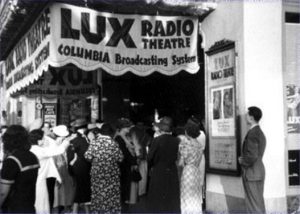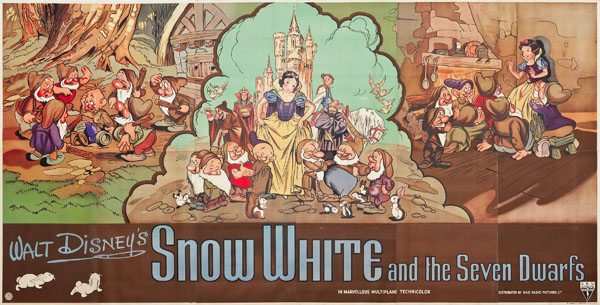
Suspended Animation # 219
“Lux Presents Hollywood” was the opening line from one of the most popular dramatic anthology series on radio that was broadcast for approximately twenty years. The Lux Radio Theater was sponsored by Lever Brothers, makers of Lux Soap.
In total, 926 episodes of the Lux Radio Theatre were made. The show was considered one of the most prestigious broadcasts during the Golden Age of Radio and there were five adaptations of Disney feature films.
 The weekly show began in New York featuring one hour versions of Broadway plays. When it moved to Hollywood in 1936, film producer and director Cecil B. DeMille took over as host and the adaptations shifted to current theatrical movies.
The weekly show began in New York featuring one hour versions of Broadway plays. When it moved to Hollywood in 1936, film producer and director Cecil B. DeMille took over as host and the adaptations shifted to current theatrical movies.
Hollywood stars performed one-hour versions of their biggest motion pictures live with no retakes but with roughly five days of rehearsal, more than any other radio show. For the most part, the original film cast was used but sometimes lead characters were replaced by equally notable performers.
In those days, once a local movie theater stopped showing a film, audiences could not see it again unless it was re-released by the studio which only happened with movies that had been big hits. With the Lux Radio Theater, fans could once enjoy a favorite film again often with the original cast even if it were trimmed to just one hour.
Movie studios licensed the radio rights for a minimal fee but often for gratis in order to get a free advertisement for an upcoming film, promote the film being broadcast and to keep their contracted stars in the spotlight.
The productions were performed live in front of an audience of one thousand people who fought aggressively for the free tickets (and a listening audience estimated at around thirty million people) and a chance to see their favorite movie stars in person. The shows featured a full orchestra and in the case of musicals included excerpts from the songs.
 For the 1938 broadcast of Snow White and the Seven Dwarfs and the 1940 adaptation of Pinocchio, Walt Disney did not want to destroy any illusions so these episodes had no studio audience but used recorded applause at the beginning and end of each act and recorded audience sounds as well when needed.
For the 1938 broadcast of Snow White and the Seven Dwarfs and the 1940 adaptation of Pinocchio, Walt Disney did not want to destroy any illusions so these episodes had no studio audience but used recorded applause at the beginning and end of each act and recorded audience sounds as well when needed.
Walt always felt that the voice was only part of the overall character. The animation and the scripting were equally important in creating the character. In the case of Snow White, only four members of the original cast recreated their roles in the radio performance.
The Disney shows were run in December as a “Christmas Gift to Our Listeners”. The Hollywood shows were broadcast from the Music Box Theater on Hollywood Boulevard and in 1940 moved to CBS Radio Playhouse located on North Vine Street about a block south of Hollywood and Vine.
The shows were mostly written by George Wells from 1934 to 1943 and Sandy Barnett from 1944 to 1955. Not only did they face the challenge of trimming the story down to the core while retaining memorable scenes or dialog but often faced the problem of how to present a silent visual film sequence on radio.
The format was always the same. The host was introduced after the overture and he talked briefly about that Monday evening’s production along with some commentary on the use of Lux soap by Hollywood’s loveliest ladies.
The show was broken up into three acts, with the breaks not only featuring short commercials for Lux but sometimes a special interview guest often promoting a film.
At the end of the show, the host would chat with the stars. At the end of Disney’s Peter Pan broadcast, Kathryn Beaumont gushed over her love of Shakespeare and her desire to see John Carradine’s one man show that featured some segments from the Bard. Carradine performed the role of Captain Hook in the show. Of course, there was another plug for Lux as well.
The host would then promote the next week’s show and announce the stars who would appear that often elicited gasps and applause from the audience.
We owe a great deal of gratitude to the work of Connie Phillips and Arthur Pierce who in their extensive research for their wonderful book, Lux Presents Hollywood, had to among other things try to put together cast lists for the shows. The Disney Archives had no listing of who performed in the Disney shows until the outstanding research of Phillips and Pierce.
Phillips and Pierce painstakingly went through payroll and expense lists as well as copies of scripts to determine what actor played which role.
Fortunately, many of these recordings still exist and a cursory search on the internet should provide an interested fan the opportunity to listen to the following shows and even the chance to purchase them on CD or download them.
To give you a head start, here is a link for the 1938 Snow White and the Seven Dwarfs show in its entirety:

• December 26, 1938: Snow White and the Seven Dwarfs
Walt pops up briefly as the intermission guest. None of the cast members were credited by name just as they were not credited in the film. The animated classic had been released the previous December and went on to world wide renown during 1938.
Cast: Thelma Hubbard (Snow White), James Eagles (Prince), Roy Atwell (Doc), Billy Gilbert (Sneezy), Rolfe Sedan (Happy), Jack Smart (Bashful), Moroni Olsen (Magic Mirror), Stuart Buchanan (Grumpy/Huntsman), Paula Winslowe (Queen), Gloria Gordon (Old Hag Witch), Lou Merrill (Sleepy).
Lou Merrill who did Sleepy was a “utility performer” along with Frank Nelson, Eddie Marr and others who filled in a variety of odd little side voices for a show or sometimes even a major supporting role.
Eddie Davis and Louise Burnett were the whistlers for the birds and Marie Green did the voice of the Echo. Ross Forrester did additional sounds.
Singers: Richard Davis, Myron Neely, Kenneth Rundquist, Harry Stanton, Freeman High, Dudley Kusell, Robert Stevens (the singing voice of the Prince as well) and Enrico Ricardi.
 Atwell, Gilbert, Olsen and Buchanan were in the original film (although Pinto Colvig did Grumpy in the film, a part that Buchanan took over for this production).
Atwell, Gilbert, Olsen and Buchanan were in the original film (although Pinto Colvig did Grumpy in the film, a part that Buchanan took over for this production).
Buchanan was the voice of the Huntsman in the film and this radio show. For awhile he was the official voice casting person at the Disney Studio. He also did the voice of the carnival barker in Pinocchio, the flight attendant in Saludos Amigos and more prominently as the voice of Goofy in the 1938 radio show The Mickey Mouse Theater of the Air.
While Thelma Hubbard (later after she married she became Thelma Boardman) never did any voices for the Snow White feature, she was no stranger to providing voices for Disney characters. She had done the speaking voice of Snow White for the 1938 Spanish dubbed version of the film. Diana Castillo did the singing voice.
From 1940 through 1942, she provided the voice for Minnie Mouse in cartoons like The Little Whirlwind, The Nifty Nineties, Mickey’s Birthday Party and Out of the Frying Pan Into the Firing Line. She also did the voice of Minnie in the short lived 1938 radio show The Mickey Mouse Theater of the Air as well as the voice of Snow White when the little princess appeared on that show.
Stay Tuned! Next week in Part Two, the other four Disney feature films to appear on Lux Radio Theater: Pinocchio, Treasure Island, Alice in Wonderland and Peter Pan.



 Jim Korkis is an internationally respected animation historian who in recent years has devoted his attention to the many worlds of Disney. He was a columnist for a variety of animation magazines. With his former writing partner, John Cawley, he authored several animation related books including The Encyclopedia of Cartoon Superstars, How to Create Animation, Cartoon Confidential and Get Animated’s Animation Art Buyer’s Guide. He taught animation classes at the Disney Institute in Florida as well as instructing classes on acting and animation history for Disney Feature Animation: Florida.
Jim Korkis is an internationally respected animation historian who in recent years has devoted his attention to the many worlds of Disney. He was a columnist for a variety of animation magazines. With his former writing partner, John Cawley, he authored several animation related books including The Encyclopedia of Cartoon Superstars, How to Create Animation, Cartoon Confidential and Get Animated’s Animation Art Buyer’s Guide. He taught animation classes at the Disney Institute in Florida as well as instructing classes on acting and animation history for Disney Feature Animation: Florida.




















































Versions of such recordings available on the internet, more often than not, are technically, hideously substandard compared to the quality in which they were recorded by professionals.
These sonic faults include bad equalization (tonality), Wow and Flutter (speed fluctuations) and distortions (fuzziness). It’s reasonable to assume (but I do not) that a large (if not a massive trove) of these programs are held at the Library of Congress. It’s possessions are “theirs” because of a years-long tax avoidance scam by which the “donors” get the lucre AND still regain control.
Also many OTR recordings are plagued with print-through, especially 3rd/4th generation dubs of transcription discs on reel-to-reel tape. Some sellers of OTR shows in the pre-CD era would record them on 4-track reels recorded at 1 7/8 IPS. Low fidelity and print-through galore.
Actually Thelma Hubbard did perform Snow White’s screams in the forest sequence of the film, along with various other little outbursts that were cut into the soundtrack in other sequences. Harry Stanton and Freeman High, listed among the singers, were also veterans of the film, having provided miscellaneous Dwarf voices for group scenes.
Many thanks for the additional information. Big fan of your book on the film (and your other books).
There is always so much more to know and discover which is one of the reasons I appreciate Jerry giving me this forum to share what I know.
Thank you, Jim, and likewise. Thanks for fleshing out the historical context of this broadcast!
In the feature BAMBI, Paula Winslowe was the voice of both Bambi’s mother and a pheasant (“Whatever you do, don’t fly.”), while Thelma Boardman was the pheasant that gets shot (“I can’t stand it any longer!”). Later in the 1960s, Winslowe would do a few voices for Season 2 of THE FLINTSTONES.